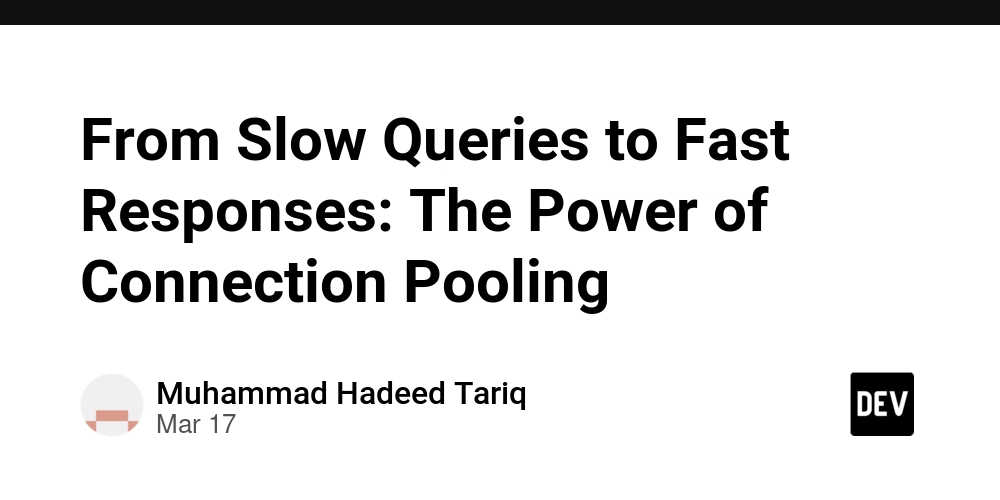From Slow Queries to Fast Responses: The Power of Connection Pooling
Introduction So, what is connection pooling? If you’re a backend developer working with databases, you've likely heard this term. You might have also come across advice on the internet suggesting that instead of opening and closing a connection to the database every time, you should use connection pooling in your application. But why? What are the benefits? Let’s dive deep into: Normal Database Interaction Downsides Diagram for Normal Database Interaction Code for Normal Database Interaction Connection Pooling Benefits of Connection Pooling Diagram for Connection Pooling Code for Connection Pooling Things to Consider When Using Connection Pooling Normal Database Interaction Normally, in an application, database interaction follows this process: A request comes to the server. The server establishes a connection to the database. The request is processed, and the response is returned. The connection is closed. To make a request and get a response, a protocol is required. This is usually TCP (Transmission Control Protocol) or gRPC (gRPC Remote Procedure Calls). Let’s assume TCP is being used. You may already know that TCP has a cost due to the three-way handshake process, which adds latency. With this native approach, every request opens a new connection to the database and then closes it after processing. Downsides High Resource Consumption: Each request creates a new TCP connection, leading to excessive resource usage. Scalability Issues: If site traffic is high, maintaining a separate connection for each user can cause the database to hit its connection limit. Increased Costs: Running many connections increases database expenses significantly. Diagram for Normal Database Interaction ![[Pasted image 20250315105705.png]] Code for Normal Database Interaction For demonstration purposes, we’ll use PostgreSQL with Node.js and the pg driver. However, you can use other drivers for different languages: 1. Python psycopg2 → Most widely used PostgreSQL adapter asyncpg → High-performance async driver for PostgreSQL SQLAlchemy → ORM that uses psycopg2 by default 2. Java PostgreSQL JDBC Driver → org.postgresql.Driver Hibernate → ORM that works with PostgreSQL via JDBC Spring Data JPA → Uses Hibernate under the hood 3. C# (.NET) Npgsql → Official PostgreSQL driver for .NET Entity Framework Core → Uses Npgsql for PostgreSQL 4. PHP PDO_PGSQL → PHP Data Object (PDO) driver for PostgreSQL pg_connect() → Native PostgreSQL function in PHP 5. Ruby pg gem → Default PostgreSQL adapter for Ruby ActiveRecord → Uses pg for PostgreSQL in Rails 6. Go pgx → High-performance PostgreSQL driver database/sql with lib/pq → Go's standard DB driver with PostgreSQL support 1. Install the pg package npm install pg 2. Create a database connection file (db.js) const { Client } = require("pg"); // PostgreSQL connection configuration const client = new Client({ user: "your_username", host: "localhost", database: "your_database", password: "your_password", port: 5432, }); // Connect to the database client.connect() .then(() => console.log("Connected to PostgreSQL!")) .catch(err => console.error("Connection error", err.stack)); module.exports = client; 3. Query the Database (index.js) const client = require("./db"); async function fetchUsers() { try { const result = await client.query("SELECT * FROM users"); console.log(result.rows); } catch (error) { console.error("Error executing query", error); } finally { client.end(); // Close the connection } } fetchUsers(); 4. Run the script node index.js In this setup, every request opens a new connection, processes the request, and then closes the connection. Connection Pooling Now, let’s discuss connection pooling and how it works. Instead of opening and closing a new connection for each request, a pool of persistent TCP connections is created. These connections remain open and are reused. When a request comes in: The application takes an available connection from the pool. The query is executed. The connection is returned to the pool for reuse. Benefits of Connection Pooling Reduces Latency: No need to establish a fresh TCP connection each time. Saves Authentication Time: The database does not need to authenticate every request separately. Scalability: The number of connections in the pool can be dynamically increased or decreased based on load. Diagram for Connection Pooling ![[Pasted image 20250316095345.png]] Code for Connection Pooling We will modify the previous code to use connection pooling instead of individual connections. 1. Create a connection pool (db.js) const { Pool } = require("pg"); // PostgreS

Introduction
So, what is connection pooling? If you’re a backend developer working with databases, you've likely heard this term. You might have also come across advice on the internet suggesting that instead of opening and closing a connection to the database every time, you should use connection pooling in your application. But why? What are the benefits?
Let’s dive deep into:
-
Normal Database Interaction
- Downsides
- Diagram for Normal Database Interaction
- Code for Normal Database Interaction
-
Connection Pooling
- Benefits of Connection Pooling
- Diagram for Connection Pooling
- Code for Connection Pooling
-
Things to Consider When Using Connection Pooling
Normal Database Interaction
Normally, in an application, database interaction follows this process:
- A request comes to the server.
- The server establishes a connection to the database.
- The request is processed, and the response is returned.
- The connection is closed.
To make a request and get a response, a protocol is required. This is usually TCP (Transmission Control Protocol) or gRPC (gRPC Remote Procedure Calls). Let’s assume TCP is being used. You may already know that TCP has a cost due to the three-way handshake process, which adds latency.
With this native approach, every request opens a new connection to the database and then closes it after processing.
Downsides
- High Resource Consumption: Each request creates a new TCP connection, leading to excessive resource usage.
- Scalability Issues: If site traffic is high, maintaining a separate connection for each user can cause the database to hit its connection limit.
- Increased Costs: Running many connections increases database expenses significantly.
Diagram for Normal Database Interaction
![[Pasted image 20250315105705.png]]
Code for Normal Database Interaction
For demonstration purposes, we’ll use PostgreSQL with Node.js and the pg driver. However, you can use other drivers for different languages:
1. Python
- psycopg2 → Most widely used PostgreSQL adapter
- asyncpg → High-performance async driver for PostgreSQL
-
SQLAlchemy → ORM that uses
psycopg2by default
2. Java
-
PostgreSQL JDBC Driver →
org.postgresql.Driver - Hibernate → ORM that works with PostgreSQL via JDBC
- Spring Data JPA → Uses Hibernate under the hood
3. C# (.NET)
- Npgsql → Official PostgreSQL driver for .NET
-
Entity Framework Core → Uses
Npgsqlfor PostgreSQL
4. PHP
- PDO_PGSQL → PHP Data Object (PDO) driver for PostgreSQL
- pg_connect() → Native PostgreSQL function in PHP
5. Ruby
- pg gem → Default PostgreSQL adapter for Ruby
-
ActiveRecord → Uses
pgfor PostgreSQL in Rails
6. Go
- pgx → High-performance PostgreSQL driver
- database/sql with lib/pq → Go's standard DB driver with PostgreSQL support
1. Install the pg package
npm install pg
2. Create a database connection file (db.js)
const { Client } = require("pg");
// PostgreSQL connection configuration
const client = new Client({
user: "your_username",
host: "localhost",
database: "your_database",
password: "your_password",
port: 5432,
});
// Connect to the database
client.connect()
.then(() => console.log("Connected to PostgreSQL!"))
.catch(err => console.error("Connection error", err.stack));
module.exports = client;
3. Query the Database (index.js)
const client = require("./db");
async function fetchUsers() {
try {
const result = await client.query("SELECT * FROM users");
console.log(result.rows);
} catch (error) {
console.error("Error executing query", error);
} finally {
client.end(); // Close the connection
}
}
fetchUsers();
4. Run the script
node index.js
In this setup, every request opens a new connection, processes the request, and then closes the connection.
Connection Pooling
Now, let’s discuss connection pooling and how it works.
Instead of opening and closing a new connection for each request, a pool of persistent TCP connections is created. These connections remain open and are reused.
When a request comes in:
- The application takes an available connection from the pool.
- The query is executed.
- The connection is returned to the pool for reuse.
Benefits of Connection Pooling
- Reduces Latency: No need to establish a fresh TCP connection each time.
- Saves Authentication Time: The database does not need to authenticate every request separately.
- Scalability: The number of connections in the pool can be dynamically increased or decreased based on load.
Diagram for Connection Pooling
![[Pasted image 20250316095345.png]]
Code for Connection Pooling
We will modify the previous code to use connection pooling instead of individual connections.
1. Create a connection pool (db.js)
const { Pool } = require("pg");
// PostgreSQL connection pool configuration
const pool = new Pool({
user: "your_username",
host: "localhost",
database: "your_database",
password: "your_password",
port: 5432,
max: 10, // Maximum number of clients in the pool
idleTimeoutMillis: 30000, // Close idle clients after 30 seconds
connectionTimeoutMillis: 2000, // Return error if connection takes longer than 2 sec
allowExitOnIdle: false, // Prevents process exit if idle clients exist
});
// Event listeners for debugging
pool.on("connect", () => {
console.log("Connected to PostgreSQL!");
});
pool.on("acquire", () => {
console.log("Client acquired from the pool");
});
pool.on("release", () => {
console.log("Client released back to the pool");
});
pool.on("error", (err) => {
console.error("Unexpected error on idle client", err);
process.exit(-1);
});
module.exports = pool;
2. Query the Database (index.js)*
const pool = require("./db");
async function fetchUsers() {
let client;
try {
client = await pool.connect(); // Get a client from the pool
console.log("Connected to database");
const result = await client.query("SELECT * FROM users");
console.log("Users:", result.rows);
} catch (error) {
console.error("Error executing query", error);
} finally {
if (client) client.release(); // Release the client back to the pool
}
}
fetchUsers();
3. Run the script
node index.js
Things to Consider When Using Connection Pooling
- Always return connections to the pool after execution. Otherwise, you might run out of connections, leading to application downtime.
- Avoid too few connections in the pool, as this can introduce latency.
- Avoid too many connections, as excessive connections may consume unnecessary resources and slow down the application.
- Set an idle timeout to release connections that remain unused for too long.
- Set a query timeout to ensure connections are not held indefinitely due to slow queries.
By implementing connection pooling, applications can significantly improve database interaction efficiency, reduce latency, and optimize resource usage.











































































































































































![[The AI Show Episode 142]: ChatGPT’s New Image Generator, Studio Ghibli Craze and Backlash, Gemini 2.5, OpenAI Academy, 4o Updates, Vibe Marketing & xAI Acquires X](https://www.marketingaiinstitute.com/hubfs/ep%20142%20cover.png)




























































































































![[DEALS] The Premium Learn to Code Certification Bundle (97% off) & Other Deals Up To 98% Off – Offers End Soon!](https://www.javacodegeeks.com/wp-content/uploads/2012/12/jcg-logo.jpg)


![From drop-out to software architect with Jason Lengstorf [Podcast #167]](https://cdn.hashnode.com/res/hashnode/image/upload/v1743796461357/f3d19cd7-e6f5-4d7c-8bfc-eb974bc8da68.png?#)








































































































.png?#)

































_Christophe_Coat_Alamy.jpg?#)
 (1).webp?#)





































































































![Apple Considers Delaying Smart Home Hub Until 2026 [Gurman]](https://www.iclarified.com/images/news/96946/96946/96946-640.jpg)
![iPhone 17 Pro Won't Feature Two-Toned Back [Gurman]](https://www.iclarified.com/images/news/96944/96944/96944-640.jpg)
![Tariffs Threaten Apple's $999 iPhone Price Point in the U.S. [Gurman]](https://www.iclarified.com/images/news/96943/96943/96943-640.jpg)




































































































































